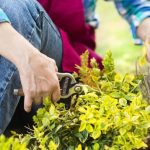Gardening is not only a fun and educational activity but also offers a myriad of benefits for kids. From teaching them about responsibility and patience to fostering a love for nature, gardening can be a rewarding experience for children. In today’s fast-paced world, introducing kids to gardening through a club setting can provide them with valuable life skills and environmental awareness.
Setting up a gardening club for kids involves creating a safe and engaging space where they can learn, explore, and grow together. By providing the right tools and supplies tailored to their size and abilities, kids can actively participate in cultivating their own plants and watching them flourish. The sense of accomplishment they gain from seeing the results of their hard work can boost their self-esteem and sense of pride.
To keep the excitement alive in kids’ gardening clubs, incorporating fun yet educational activities is essential. From planting seeds to learning about pollinators, there are numerous hands-on projects that can spark curiosity and creativity in young gardeners. Seasonal gardening projects can also provide opportunities for children to understand the importance of timing, weather conditions, and plant growth cycles.
Setting Up a Gardening Club for Kids
Starting a gardening club for kids is a rewarding and educational experience that can teach children valuable skills while fostering a love for nature and the environment. To set up a successful gardening club, there are some basics that need to be covered. Here are some essential steps to consider:
- Recruit interested children: Start by reaching out to students, parents, or the community to gauge interest in starting a gardening club. Create flyers or announcements to spread the word.
- Secure a location: Whether it’s a school garden, community garden plot, or even just individual raised beds, make sure you have access to an appropriate space where the children can plant and tend to their gardens.
- Establish guidelines: Set clear expectations for participation, behavior, and responsibilities within the gardening club. Creating a simple schedule of activities can help keep everyone organized and engaged.
When setting up your gardening club for kids, don’t forget about the importance of safety. Make sure to provide appropriate tools and supplies for the children to use and establish rules regarding garden safety. Encourage adult supervision or volunteer involvement to ensure that children are properly guided in their gardening activities.
With these basics in mind, your gardening club for kids will be well on its way to providing youngsters with valuable hands-on learning experiences while fostering their appreciation for nature and the environment. By creating an engaging and structured environment, children can develop important life skills such as responsibility, teamwork, patience, and environmental stewardship – all while having fun with gardening activities.
Essential Tools and Supplies for Kids’ Gardening Clubs
When setting up a gardening club for kids, it is important to ensure that they have the necessary tools and supplies to maximize their gardening experience. Here are some essential items that every kids’ gardening club should have:
- Child-sized gardening gloves: Providing children with gloves that fit properly will not only protect their hands from dirt and potential prickly plants but also make them feel more comfortable while working in the garden.
- Hand trowels and shovels: These tools are essential for digging, planting, and transferring soil, giving kids a hands-on experience in cultivating the earth.
- Watering cans or spray bottles: Encouraging kids to water their plants is crucial for their growth. Using child-sized watering cans or spray bottles makes this task easier and more enjoyable for young gardeners.
- Seeds or seedlings: Of course, no gardening club can thrive without seeds or seedlings. Allow children to choose the plants they want to grow, fostering their interest and engagement in the process.
- Garden journals or notebooks: Providing kids with a place to record observations, drawings, and progress in their gardens can enhance their learning experience and help them track the growth of their plants over time.
By ensuring that your kids’ gardening club is equipped with these essential tools and supplies, you can set the stage for a successful and enriching gardening experience for children. With the right resources at hand, young gardeners can learn valuable skills while having fun exploring the wonders of nature.
Fun and Educational Gardening Activities for Kids
One of the key aspects of running a successful gardening club for kids is ensuring that the activities are not only fun but also educational. Incorporating a mix of engaging and informative tasks can help children develop a love for gardening while learning valuable skills along the way.
One great gardening club idea for kids is to create a butterfly garden. This project not only teaches children about different plant species and how to care for them but also allows them to witness the life cycle of butterflies up close.
Another exciting activity for kids’ gardening clubs is creating a vegetable garden. Kids can learn how to plant, nurture, and harvest vegetables, giving them a sense of accomplishment and responsibility.
This hands-on experience can also encourage children to eat healthier and appreciate where their food comes from. To make this activity even more engaging, you can organize a mini farmers’ market at the end of the season where kids can sell their produce or donate it to a local charity.
In addition to these activities, incorporating arts and crafts projects into your gardening club can add a creative element for kids to enjoy. For example, you can have children paint colorful plant markers, decorate flower pots, or make DIY bird feeders using recycled materials.
Not only will these projects enhance their gardening experience, but they will also allow children to express their creativity and individuality. By offering a variety of fun and educational activities in your gardening club, you can inspire young minds to explore nature, develop new skills, and cultivate a lifelong passion for gardening.
| Beneficial Gardening Activities | Learning Outcomes |
|---|---|
| Butterfly Garden Project | Understanding plant species and butterfly life cycles |
| Vegetable Garden Experience | Developing responsibility, appreciation for food sources |
| Arts and Crafts Projects | Fostering creativity while enhancing gardening experience |
Seasonal Gardening Projects for Kids
Gardening offers a wealth of opportunities for children to learn, explore, and have fun. One of the best ways to keep kids engaged throughout the year is by introducing seasonal gardening projects. In the spring, kids can get their hands dirty planting seeds, learning about germination, and watching their plants grow.
Summer is perfect for activities like creating a butterfly garden or building bird feeders to attract wildlife. As fall approaches, kids can enjoy harvesting fruits and vegetables they planted earlier in the season.
One exciting seasonal project that kids can participate in during the winter months is indoor gardening. Setting up a small indoor garden with herbs or houseplants not only teaches children about plant care but also introduces them to the concept of growing food indoors.
Watching plants thrive despite the colder weather outside can be a rewarding experience for young gardeners. Additionally, incorporating seasonal themes like planting flowers for spring or growing pumpkins for fall can make gardening even more engaging and educational for kids.
Engaging in different seasonal gardening projects throughout the year not only keeps children interested but also allows them to witness the full cycle of plant growth and development. It provides valuable lessons about nature’s rhythms and how different seasons impact plant life. By encouraging kids to participate in seasonal gardening activities, parents and educators can help foster a love for nature and cultivate essential skills such as responsibility, patience, and environmental awareness.
| Seasonal Gardening Project | Benefits |
|---|---|
| Indoor Herb Garden | Teaches plant care skills; Introduces growing food indoors |
| Butterfly Garden | Attracts wildlife; Provides an educational opportunity about butterflies |
| Fall Harvesting | Allows kids to harvest fruits & vegetables they planted; Teaches about seasonality |
How to Incorporate Environmental Education Into Gardening Club Activities
Learning About Soil Health
One way to incorporate environmental education into gardening club activities is by teaching kids about soil health. This can involve discussing the importance of healthy soil for plant growth, the role of microorganisms in the soil, and how to improve soil quality through composting and organic fertilizers. Kids can learn hands-on by testing the pH levels of soil, identifying different types of soil, and understanding the benefits of mulching.
Water Conservation and Management
Another important aspect of environmental education in gardening clubs is teaching kids about water conservation and management. Kids can learn about the water cycle, ways to reduce water waste in gardening practices, and sustainable irrigation methods such as drip irrigation or rainwater harvesting. By emphasizing the importance of using water wisely in the garden, children can develop a greater appreciation for natural resources and become more conscious of their environmental impact.
Exploring Biodiversity in the Garden
Kids’ gardening clubs can also focus on exploring biodiversity in the garden as part of their environmental education efforts. This can include learning about beneficial insects, pollinators, and companion planting techniques that promote a diverse ecosystem in the garden.
Children can participate in scavenger hunts to identify different plant species, create wildlife habitats like bird feeders or bug hotels, and observe how various species interact within the garden environment. By understanding the interconnectedness of living organisms in nature, kids can develop a deeper respect for biodiversity and its role in sustainable gardening practices.
By incorporating these environmental education aspects into gardening club activities, kids not only learn valuable skills related to horticulture but also gain a better understanding of their role in preserving and protecting the environment. Gardening club leaders can inspire young participants to become stewards of the land by fostering a sense of responsibility towards nature while having fun exploring all the wonders that gardening has to offer.
Building a Sense of Community and Teamwork in Kids’ Gardening Clubs
When it comes to fostering a sense of community and teamwork in kids’ gardening clubs, there are several strategies that can be implemented to create a supportive and collaborative environment for young gardeners. One approach is to encourage group projects where children work together to achieve common goals, such as planting a communal vegetable garden or creating a themed flower bed.
This not only allows kids to learn how to cooperate and communicate effectively with their peers but also instills a sense of shared responsibility and accomplishment.
Team-Building Activities
Incorporating team-building activities into the gardening club’s schedule can help strengthen bonds between members and promote a spirit of unity. Group challenges, relay races, or scavenger hunts related to gardening tasks can be enjoyable ways for kids to work together towards a common objective. These activities not only enhance their cooperation skills but also make the learning process more interactive and engaging.
Community Outreach Projects
Engaging in community outreach projects is another effective way to instill a sense of social responsibility and empathy in young gardeners. Kids’ gardening clubs can organize events such as plant sales, beautification projects in public spaces, or outreach programs aimed at teaching other children about the joys of gardening.
By giving back to their communities and working towards shared goals outside of their club activities, children develop a deeper understanding of the importance of teamwork and collaboration in making positive impacts on the world around them.
Showcasing Kids’ Gardening Club Success Stories
When it comes to starting a kids’ gardening club, drawing inspiration from success stories of existing clubs can be incredibly motivating and insightful. Seeing the positive impacts that gardening has had on other children can encourage new clubs to flourish and thrive.
One key element in showcasing these success stories is highlighting the growth, development, and achievements of young gardeners who have participated in these clubs. By sharing their experiences, challenges, and triumphs, new clubs can gain valuable insights into what works well and how to navigate potential obstacles.
One inspiring success story comes from a kids’ gardening club in a local elementary school that transformed an unused plot of land into a vibrant garden oasis. Over the course of a single growing season, the young gardeners cultivated an abundance of fruits, vegetables, and flowers, all while learning about plant care, composting, and environmental stewardship.
The sense of pride and accomplishment felt by the children as they harvested their first crops was truly heartwarming. This particular club’s dedication to nurturing both plants and friendships amongst its members serves as a shining example of how gardening can foster teamwork, responsibility, and a deep connection to nature.
Another noteworthy success story involves a community-based gardening club that partnered with local businesses to create a series of interactive workshops for kids. From seed-starting sessions to DIY scarecrow building activities, these workshops not only engaged children in hands-on gardening but also provided valuable lessons in creativity and resourcefulness.
The positive feedback received from parents, volunteers, and participants alike is a testament to the impact that such collaborative initiatives can have on shaping young minds. These success stories remind us that through creativity, cooperation, and passion for nature, kids’ gardening clubs have the potential to make a lasting impact on both individuals and communities alike.
Celebrating the Harvest
In conclusion, celebrating the harvest with an end-of-season party is a fantastic way to wrap up the activities of a kids’ gardening club. It serves as a time to reflect on all the hard work put in by the young gardeners and celebrate their accomplishments. The end-of-season party can also foster a sense of pride and ownership among the kids as they see the fruits of their labor come to life.
One fun idea for an end-of-season party is to organize a mini farmers’ market where kids can set up booths to sell the produce they have grown. This not only gives them a chance to showcase their harvest but also teaches them valuable lessons about marketing, money management, and customer service.
Another popular option is to host a garden-themed cooking competition using ingredients grown in the club’s garden. This can encourage creativity in the kitchen and further reinforce the connection between growing food and eating healthy.
Additionally, incorporating craft activities such as making plant markers or creating flower arrangements using items from the garden can add a creative touch to the celebration. It’s also essential to acknowledge and appreciate the hard work of all participants by handing out certificates of achievement or small prizes.
Ultimately, these end-of-season parties not only serve as a fun way to mark the end of another successful season but also help instill a sense of community spirit and teamwork among young gardeners in kids’ gardening clubs.
Frequently Asked Questions
How Do I Start a Garden Club for Kids?
Starting a garden club for kids can be a fun and rewarding experience. Begin by gathering interested children, parents, or teachers who are willing to help. You’ll need to find a suitable meeting place, such as a community center or school garden. Plan engaging activities like planting seeds, learning about different plants, and nurturing the garden together.
What Do People Do in a Garden Club?
A garden club offers plenty of opportunities for kids to get involved in various gardening-related activities. Members can learn how to plant seeds, care for plants, design their own garden plots, and participate in hands-on projects like creating compost bins or building bird feeders. Additionally, they can explore topics like soil health, beneficial insects, and sustainable gardening practices.
What Can You Teach Kids About Gardening?
Teaching kids about gardening goes beyond just planting seeds and watering plants. By involving them in a garden club, you can impart valuable knowledge about the natural world, sustainability, and healthy eating habits.
Kids can learn about the life cycle of plants, the importance of pollinators like bees and butterflies, how to identify different herbs and vegetables, and even basic botany concepts like photosynthesis. Gardening also teaches children responsibility, patience, teamwork, and appreciation for nature’s beauty.

Welcome to my gardening blog! I am passionate about plants and enjoy sharing my knowledge and experiences with others. In this blog, I will write about everything related to gardening, from tips on how to get started to updates on my own garden projects.





